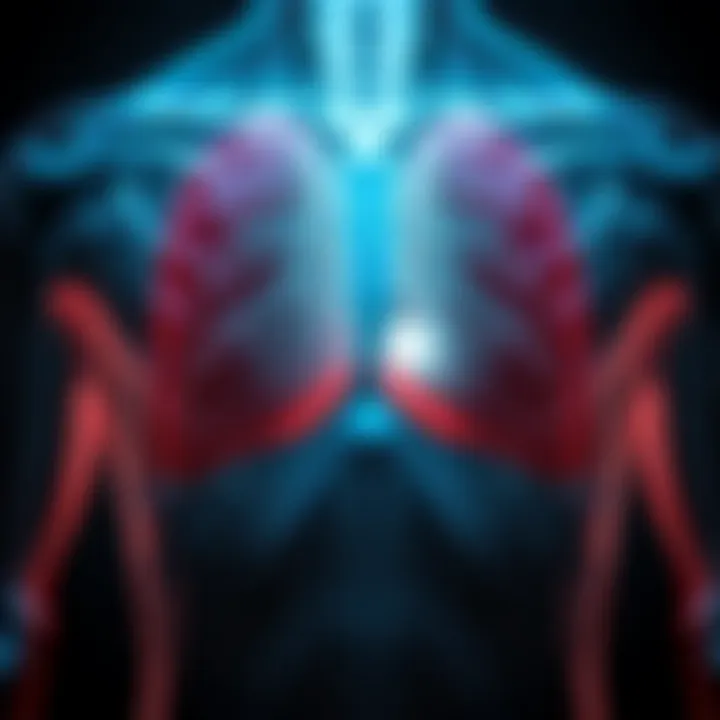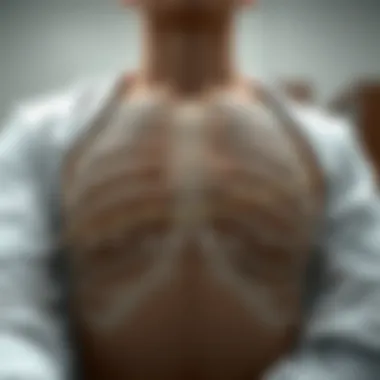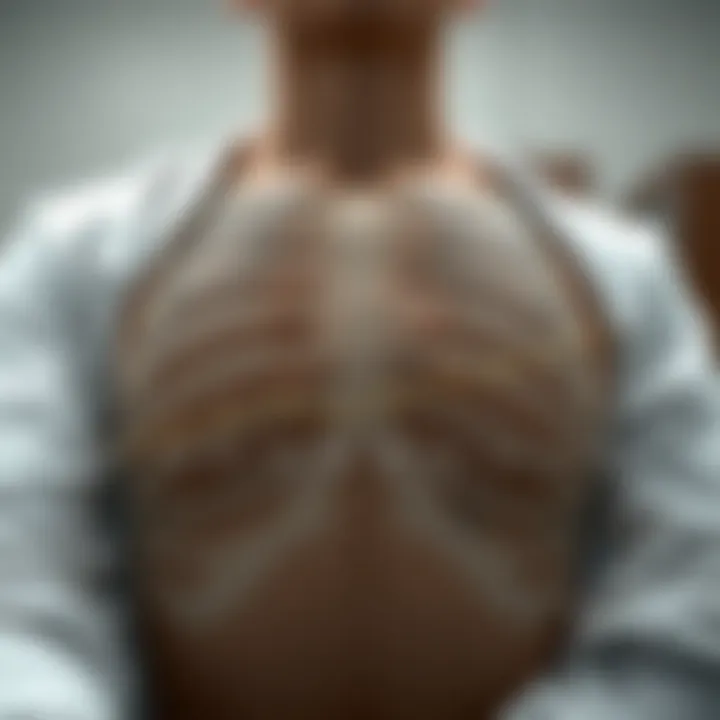Understanding Pectus Excavatum: Diagnosis and Treatment


Intro
Pectus excavatum, often known as sunken chest syndrome, represents a significant chest wall deformity characterized primarily by a notable depression in the sternum. This condition not only influences the aesthetic appearance of the chest but can also contribute to numerous health issues, including respiratory problems and cardiac concerns. Understanding the multifaceted aspects of this deformity is crucial for both healthcare providers and those affected.
The path to diagnosing and treating pectus excavatum encompasses a variety of nuances from identifying the specific features of the condition to considering the psychological implications it may impose on individuals. While the physical aspects draw immediate attention, the emotional and social outcomes warrant thorough exploration. This article serves to dissect the complexities surrounding pectus excavatum, ranging from clinical insights to treatment approaches, paving the way for an informed understanding of this prevalent condition.
By analyzing recent findings, treatment methodologies—including both surgical and non-surgical options—and the long-term implications of various interventions, the aim is to provide a detailed roadmap for medical professionals, educators, and laypersons alike. The intricate balance between functionality, aesthetics, and psychological well-being constitutes a significant aspect of this analysis, which makes it imperative to delve deeper into the research context surrounding pectus excavatum.
Foreword to Pectus Excavatum
Pectus excavatum stands as a significant medical condition that demands a closer look. This syndrome, characterized by the inward displacement of the sternum, can bring about several concerns that range from aesthetic to functional. Understanding its implications is crucial not just for the individuals affected but also for medical professionals who encounter the various manifestations of this condition. The multifaceted nature of pectus excavatum opens up avenues for extensive exploration in terms of diagnosis, therapeutic interventions, and long-term effects.
For those who live with pectus excavatum, the challenges may extend beyond mere physical appearance. There can be a swirl of emotional and social ramifications that complicate everyday life. As the stigma surrounding physical deformities is often deep-rooted, comprehending these aspects is vital for fostering empathy and informed care. Further, this condition can give rise to potential health complications, such as respiratory or cardiac issues, thus showcasing the need for a thorough understanding since it can significantly impact life quality. Highlighting these interconnected elements transforms our approach to pectus excavatum from a mere clinical diagnosis into a comprehensive patient-centered discussion.
By peeling back the layers of this condition, we aim to provide insights that integrate both medical and psychosocial frameworks, thus offering a holistic perspective on pectus excavatum. Such an in-depth understanding can lead to improved treatment strategies and better support systems for those grappling with its effects.
Definition and Overview
Pectus excavatum, colloquially known as funnel chest, occurs when the breastbone, or sternum, develops a concave shape, often described as sunken or depressed. This anomaly typically manifests during childhood or adolescence, with varying degrees of severity. In some patients, it may present as a mild cosmetic concern, while in more pronounced cases, it could result in functional impairments. The extent of the sunken appearance can not only affect one’s confidence but can also compress internal organs, leading to physical challenges.
While its exact prevalence remains somewhat obscure, estimates indicate that it affects about one in every 300 to 1,000 live births, being more common in males than females. The cause of pectus excavatum is not fully understood, though genetic predispositions play a considerable role, alongside developmental factors.
Historical Context
Tracing back the narratives of pectus excavatum unveils a history steeped in misunderstanding and misdiagnosis. Historical texts suggest that even in ancient times, this chest deformity was documented, but without substantive medical guidance. Initially regarded merely as a cosmetic flaw, pectus excavatum was seldom treated unless deemed severe—many physicians failed to recognize the associated respiratory or cardiac implications.
Through the years, as medical knowledge advanced, there was a gradual shift toward treatment. The mid-20th century heralded a revolutionary approach with the introduction of surgical techniques tailored specifically for this condition. Surgeons like Dr. Donald Nuss advocated for the Nuss Procedure, which was a turning point in how pectus excavatum was perceived and treated, emphasizing the need for correction not just for aesthetic reasons but for significant health benefits as well.
This evolution in understanding pectus excavatum reflects a broader societal movement toward recognizing physical variances and their potential impacts. As more professionals and advocates delved into the psychosocial aspects of the condition, an integrated approach began to emerge, focusing on treating the whole person rather than just the physical symptoms.
Etiology of Pectus Excavatum
Understanding the etiology of pectus excavatum provides valuable insights into its origins, influencing factors, and potential implications for those affected by it. This section plays a crucial role in recognizing how both genetic predispositions and environmental elements contribute to this chest deformity. By exploring these aspects, healthcare professionals and patients alike can better understand the condition, facilitating informed discussions regarding its management and treatment options. A nuanced grasp of etiology also aids in developing targeted interventions, whether surgical or non-surgical, thereby enhancing overall patient outcomes.
Genetic Factors
The genetic underpinnings of pectus excavatum cannot be overlooked. Emerging research suggests there may be familial patterns associated with the condition, indicating a hereditary component. Many individuals with this deformity report having close relatives with similar sternum characteristics, hinting that genetics plays a role.
Research has identified certain genetic markers that might predispose individuals to develop pectus excavatum, highlighting the importance of genetic counseling in affected families. Current studies are especially considering the role of specific genes linked to connective tissue disorders. For instance, mutations in genes associated with structural proteins could potentially explain the abnormal development of the chest wall seen in some patients.
This genetic link can have several implications:
- Family History: Patients with a family history of pectus excavatum should undergo a thorough evaluation to determine their own risk.
- Early Diagnosis: Identifying genetic factors might lead to earlier diagnosis, as children of affected individuals might benefit from regular check-ups.
- Research Focus: Increased awareness of genetics may prompt further studies into tailored treatment modalities based on genetic profiles.
Environmental Influences
Beyond genetics, environmental factors also play an important role in the development of pectus excavatum. The interaction between an individual's genetics and their surrounding environment may shape the severity and presentation of the condition. Historical data suggests that lifestyle and physical factors contribute over time.
- Nutritional Aspects: A malnourished state during critical growth periods can affect skeletal development. For instance, insufficient intake of essential nutrients may interfere with proper chest wall structure, potentially leading to deformities like pectus excavatum.
- Physical Activities: Certain activities or the lack thereof could influence the development of the chest wall. Children with less physical activity may not develop stronger chest muscles to support and counteract abnormal growth patterns in cartilage.
- Posture and Ergonomics: Children who spend extended periods in poor postural positions, such as slouching while using devices, may exacerbate or contribute to the severity of chest deformities.
"Understanding both genetic and environmental influences could pave the way for preventive measures and more effective treatment strategies."
Different studies are continuously examining these variables to draw more conclusive connections concerning their impact. Knowledge in this realm is pivotal for both prevention and managing pectus excavatum effectively.
Clinical Presentation
The clinical presentation of pectus excavatum is fundamental for diagnosis and treatment planning. It's the first step in understanding how this condition manifests and affects individuals. Assessing the physical characteristics, associated symptoms, and overall health impact gives clinicians a comprehensive view. It also helps in tailoring treatment approaches that align with the patient's unique needs. Thus, grasping this aspect is crucial for healthcare professionals and affected individuals alike.
Physical Examination Findings
During a physical examination, specific signs of pectus excavatum are observable. The most notable finding is a concave depression in the sternum, which can vary in depth and severity. The chest wall may appear asymmetrical, with one side of the rib cage possibly protruding more than the other. This condition can be more pronounced during activities that increase thoracic pressure, like deep breathing or physical exertion.


Moreover, a clinician might assess the flexibility of the chest wall. It's not uncommon for patients with a more significant deformity to exhibit limited range of motion in the thoracic area, which can be attributed to constrained lung expansion. The importance of a thorough physical examination lies in its role in correlating these physical findings with the patient's reported symptoms, ultimately guiding further diagnostic evaluations.
Associated Symptoms
The symptoms associated with pectus excavatum can be quite varied and impact multiple facets of a person's life. This section delves deeper into the specific areas where individuals may experience complications.
Respiratory Complications
Respiratory complications often emerge as a significant concern in individuals with pectus excavatum. The sternum's depression can hinder normal lung expansion, leading to reduced vital capacity—the maximum amount of air the lungs can hold. As a result, patients may experience shortness of breath during physical exertion, which can be particularly concerning for younger individuals who are often active in sports.
A characteristic feature of these complications is the reliance on increased effort to breathe, especially during times of high demand. Patients may not recognize these symptoms right away, often attributing them to lack of fitness or other common ailments. The advantageous aspect of specifically highlighting respiratory concerns is that addressing these issues can significantly improve a patient's quality of life. Early identification can open pathways to interventions that enhance respiratory function.
Cardiac Issues
Cardiac issues may also surface as an associated symptom of pectus excavatum. The heart resides in close proximity to the sternum, and a depressed chest wall can compress the heart, leading to arrhythmias or other heart-related symptoms. While these issues are less common, they hold significant relevance in the overall understanding of the condition's impact.
One key characteristic is that cardiac symptoms can manifest subtly, often mistaken for anxiety or vague discomfort. As such, patients may find themselves struggling with palpitations or irregular heartbeats, particularly under stress or exertion. It is important to stress the need for cardiac evaluations, especially during a clinical assessment. Recognizing these symptoms not only benefits immediate health but also informs overall management of pectus excavatum.
Psychosocial Implications
The psychosocial implications of pectus excavatum can be profound. Many individuals suffering from this condition report issues related to self-esteem and social anxiety. The appearance of the chest, often viewed as a hallmark of masculinity or femininity, can lead to feelings of inadequacy.
One striking feature is the ambivalence patients experience—while they might wish to talk about their condition for support, the stigma often makes them reluctant. This can create a cycle where the lack of open dialogue reinforces feelings of isolation. Emphasizing the psychosocial aspect demonstrates that the effects of pectus excavatum are more than physical; they impact mental health, reinforcing the importance of integrated care approaches that address both physical deformities and the emotional well-being of those affected.
"Pectus excavatum is more than just a physical appearance issue; it draws into question emotional stability and social integration."
Diagnosis of Pectus Excavatum
Diagnosing pectus excavatum is a critical step in managing this condition. Superficially, it might just seem like an aesthetic concern, but a thorough diagnosis can reveal underlying complications that may necessitate medical intervention. Accurate diagnosis yields a better understanding of the severity of the deformity, potential associated symptoms, and the appropriate course of treatment. Furthermore, it helps to tailor management options to the individual’s specific needs, thereby optimizing outcomes and improving overall quality of life.
Imaging Techniques
Chest X-ray
Chest X-rays serve as the first line of diagnostic imaging when evaluating pectus excavatum. This straightforward technique captures an initial view of the thoracic cavity, allowing healthcare professionals to assess the structure of the sternum and surrounding ribs. One notable characteristic of chest X-rays is their accessibility; they are widely available in clinical settings.
The primary advantage of a chest X-ray is its ability to quickly reveal the profile of the chest wall, aiding in the identification of pectus excavatum. However, while they are beneficial for initial assessments, they may not provide a comprehensive evaluation of the extent of the deformity or any potential implications on the heart and lungs. The images can sometimes lack detail, leading to underdiagnoses or missed anomalies that require further exploration.
CT Scans
In contrast, CT scans offer more detailed insights into the structural nuances of the chest wall. This imaging technique enables a three-dimensional assessment, which is invaluable for understanding the severity of pectus excavatum and its impact on surrounding anatomical structures. The high-resolution images produced by CT scans can show the degree of sternal depression and even reveal any associated complications like compression on vital organs.
One of the most significant benefits of CT scans is their ability to provide quantifiable data. By using measurements derived from the scans, healthcare providers can gauge the severity of the condition, which aids in making informed decisions about treatment options. However, the downsides include higher costs and exposure to radiation, so the decision to utilize this imaging must be carefully weighed.
Functional Assessments
Functional assessments play a complementary role in the diagnosis of pectus excavatum, focusing on how the condition affects bodily functions. This includes evaluating respiratory function through spirometry tests and assessing the cardiovascular system with echocardiograms. Such assessments are pivotal, especially when considering surgical interventions, as they provide insights into what complications might arise from the deformity. In the end, the culmination of imaging studies and functional assessments forms a holistic view of the patient's condition, guiding both treatment and ongoing management.
Treatment Options
When discussing pectus excavatum, how one addresses the condition holds paramount importance. Treatment choices can significantly influence physical health and psychosocial well-being, so it’s vital to understand the landscape of available methods. Solutions can broadly be classified into non-surgical management and surgical interventions, each having its pros and cons.
Non-Surgical Management
Physical Therapy
Physical therapy can play a significant role in managing symptoms linked with pectus excavatum. This approach mainly focuses on strengthening the muscles around the chest, improving posture, and enhancing lung capacity. One key characteristic of physical therapy is its focus on individualized care, tailoring exercises to suit personal needs.
Patients often find physical therapy to be a popular choice as it fosters an active role in their recovery, allowing them to feel empowered. A unique feature of this approach lies in its gentleness; there are no invasive procedures involved, making it a low-risk option for many. However, its effectiveness may vary. Some patients might not experience sufficient relief from symptoms unless they later consider surgical options.
Bracing Techniques


Bracing techniques present another non-invasive avenue for managing pectus excavatum. These devices aim to physically support the chest wall, helping to guide it toward a more typical shape over time. A significant characteristic of bracing is its potential for gradual correction, as it is a less aggressive method than surgery. This can be particularly beneficial for younger patients who are still growing.
The uniqueness of bracing lies in its adjustable nature – braces can be tailored for comfort and fitted to individual anatomy, leading to better compliance among users. However, one must consider that results can be slow and the user needs to commit to consistent use for a more extended period.
Surgical Interventions
Nuss Procedure
The Nuss procedure is often a go-to surgical intervention for correcting pectus excavatum. This minimally invasive technique involves placing a curved metal bar under the sternum to elevate it into a more typical position. A standout point about the Nuss procedure is its reduced recovery time compared to traditional surgical methods, which appeals to both patients and surgeons alike.
With this method, patients can expect a significant improvement in their physical appearance and functional capacity. However, potential complications, such as bar displacement or infection, can occur, and patients must weigh these risks against the expected benefits.
Ravitch Procedure
On the other hand, the Ravitch procedure takes a different approach by removing cartilage and reshaping the chest wall. This surgical intervention is more invasive but is often favored in cases where a deeper correction is needed. A crucial characteristic of the Ravitch technique is the permanence of its results, leading many to consider it for long-term solutions.
What sets it apart is that while it may require a longer recovery time, the procedure can yield gratifying results. Still, the invasiveness may deter some patients who prefer less impactful solutions.
Postoperative Care
Postoperative care remains an essential aspect of the treatment pathway for patients undergoing either of the procedures mentioned above. This entails meticulous monitoring of the surgical site to prevent infection and ensuring that recovery is proceeding on course. A key component of postoperative care is pain management, which plays a vital role in a patient’s ability to regain mobility and return to normal activities.
A unique feature of this care is the potential for physical therapy to be implemented in the healing process. This dual focus can enhance surgical outcomes, as physical rehabilitation directly following surgery can strengthen the chest area and expedite recovery. However, patients must be mindful of adhering to their doctors’ guidelines, as neglecting proper care can lead to complications.
In summary, the treatment options available for pectus excavatum can vary widely, providing patients with choices that can suit their unique situations and preferences. Understanding these approaches, whether non-surgical or surgical, allows informed decisions on the best route toward achieving improved health and confidence.
Outcomes of Treatment
The discussion surrounding the outcomes of treatment for pectus excavatum is pivotal in understanding the overarching impact this condition bears on individuals. A clear grasp of both short-term and long-term results not only aids clinical decision making but also offers patients and their families a realistic picture of what to anticipate post-treatment.
Ultimately, the outcomes serve as a rich tapestry of physical improvement, emotional health, and quality of life enhancements. This section will dive deeper into these outcomes, focusing on the specifics that can inform and shape treatment pathways.
Short-Term Outcomes
Immediately following treatment, patients often experience a range of short-term outcomes. These can vary based on the treatment modality employed—whether surgical or non-surgical. Generally, patients report a decrease in discomfort and a noticeable shift in physical appearance, which can be somewhat gratifying shortly after intervention.
However, it’s important to note that the road to recovery often comes with its own set of challenges. For example:
- Pain Management: Patients, particularly those who have undergone surgical options like the Nuss or Ravitch procedure, may encounter post-operative pain that takes time to manage effectively.
- Physical Limitations: Initially, many patients might notice limitations in their ability to engage in normal activities, including sports or exercise, which can be frustrating given their eagerness to return to a pre-treatment state.
Despite these hurdles, most individuals witness physical improvements soon after treatment. Breathing patterns may become more normalized, contributing to enhanced functionality in daily life. This initial phase can be regarded as a crucial time that lays the groundwork for longer-term outcomes.
Long-Term Results
Looking beyond the immediate adjustments, long-term results of treatment for pectus excavatum significantly shape the ongoing wellbeing of affected individuals. Here, we will unpack two critical subcategories: Physical Appearance and Psychosocial Effects.
Physical Appearance
The enhancement of physical appearance post-treatment is often one of the most celebrated outcomes. Patients tend to feel a sense of renewed confidence as their thoracic contour improves.
- Key Characteristics: The lines of the chest after successful treatment typically appear smoother and more aligned with natural anatomy, which can vastly improve one’s self-image. A chest that no longer appears caved-in fosters feelings of normalcy and acceptance.
- Benefits: Improved self-image can lead to a myriad of social benefits. Individuals might find themselves more inclined to engage socially or participate in activities they previously avoided due to body image concerns.
On the flip side, it's important to recognize that not everyone will experience the same level of aesthetic satisfaction, and some may grapple with ongoing concerns about their appearance.
Psychosocial Effects
Many underestimate the psychosocial effects associated with pectus excavatum treatment. These effects can carry immense weight in a person’s life.
- Key Characteristic: Psychological outcomes can range from improved self-esteem to a diminished sense of social anxiety. Many patients report a lower level of embarrassment and a greater willingness to interact without the fear of judgment.
- Advantages: Enhanced psychological wellbeing often leads to a better quality of life, where individuals can pursue career aspirations, relationships, and social connections without the overshadowing presence of their earlier embarrassment.
Nonetheless, post-treatment, some individuals may still struggle with lingering self-doubt or social anxiety, highlighting the importance of psychosocial support throughout the treatment continuum.


The cumulative effect of surgery on both physical appearance and psychosocial wellbeing illustrates the profound impact of successful treatment on the quality of life for individuals with pectus excavatum.
Concluding this section, understanding the outcomes of treatment is not just a clinical obligation; it is crucial for fostering empathy and compassion in care, ultimately guiding successful recovery journeys.
Psychosocial Considerations
The impact of pectus excavatum extends beyond physical health; it permeates deeply into the realms of psychological and social wellbeing. Addressing the psychosocial aspects of this condition is crucial because they can significantly influence the quality of life for individuals affected. The interplay between physical appearance and mental health fosters a complex environment where self-perception, interpersonal relationships, and overall emotional health are subjected to multiple pressures. As such, it becomes imperative to consider the various dimensions that contribute to the psychosocial landscape surrounding pectus excavatum.
Impact on Self-Esteem
Individuals with pectus excavatum often grapple with self-esteem issues. The visible contour of the chest can elicit feelings of insecurity and self-consciousness. It's not merely a matter of aesthetics; for some, it affects how they view themselves in relation to peers. Research shows that variations in chest appearance can create a ripple effect, leading to anxiety, depression, or body image dissatisfaction. The experiences can range widely:
- Adolescent Reactions: During formative years, many adolescents are sensitive to how they are perceived. Comments from peers can sting, and the unique physicality of someone with a sunken chest can prompt ridicule or unhelpful comparisons.
- Adult Perceptions: As individuals mature, they often become more aware of societal standards. Adults encountering these challenges may face hurdles in professional environments and romantic relationships. This awareness can lead to self-criticism based on their condition.
The emotional consequences can vary greatly. For some, feelings of inadequacy might persist unless addressed. To combat these issues, tackling self-esteem from a holistic standpoint can be beneficial, focusing not only on physical treatment but also on mental and emotional well-being.
Social Interactions
The influence of pectus excavatum on social interactions is another vital consideration. The state of one's self-esteem often shapes how one interacts with others. Many individuals might avoid social settings or feel compelled to downplay their physical appearance. This retreat can lead to:
- Isolation: Perceived judgment can cause individuals to withdraw from friends or social gatherings, fostering loneliness. This behavior often gets exacerbated in environments like schools or workplaces where peer acceptance is highly valued.
- Communication Barriers: Individuals may struggle to assert themselves in conversations due to insecurities about their appearance, leading to misunderstandings or missed opportunities in both personal and professional spheres.
Transforming these social experiences is an essential aspect of managing pectus excavatum. Support groups or counseling can encourage individuals to openly discuss their sentiments, enabling healthier relationship dynamics.
Current Research Directions
In the realm of pectus excavatum, ongoing research is vital in piecing together the complexities of this condition. As medical professionals strive toward more effective methods of diagnosis and treatment, current research directions shed light on innovative strategies and genetic underpinnings that could drastically enhance patient outcomes. This section aims to delve into the nuances of cutting-edge treatment modalities and the significance of genetic studies, both of which are critical in forming a well-rounded understanding of pectus excavatum.
Innovative Treatment Modalities
Innovative treatment modalities represent a frontier of hope for individuals affected by pectus excavatum. Traditional surgical procedures like the Nuss and Ravitch methods have established their place in clinical practice. However, researchers are now exploring less invasive alternatives that hold promise for minimizing recovery time and discomfort.
For instance, one avenue of exploration focuses on the use of 3D printing technology. This advancement allows for the creation of custom implants that may be more comfortable and effective than standard options. By tailoring the implant to fit an individual's specific anatomy, surgeons may enhance the overall functional outcomes. Technologies like these promise to reduce complications and improve aesthetic results, appealing to both patients and healthcare providers alike.
Innovative solutions such as customized implants and less invasive techniques mark a potential game changer in the management of pectus excavatum.
Moreover, non-surgical methods, including vacuum bell therapy, have started to gain traction. Initially used for mild cases, this treatment employs a suction mechanism to gradually elevate the sternum. Studies suggest that this method can enhance cosmetic outcomes significantly, offering an alternative for those who may not want surgical intervention.
As we look ahead, it’s paramount to consider research directions in this field, as they can lead to breakthroughs that improve the quality of life for countless patients. Thus, the examination of innovative treatment methodologies stands as a crucial pillar in the journey toward enhanced management of pectus excavatum.
Genetic Studies
Transitioning from advanced treatment methods, the study of genetic factors underlying pectus excavatum has gained momentum as researchers seek to understand this condition from a molecular perspective. Genetic studies aim to reveal pivotal information that can provide insights into disease predisposition and inform future treatment strategies.
Recent efforts have honed in on identifying specific gene mutations that may increase the risk of developing pectus excavatum. Understanding these genetic components could unveil mechanisms behind the condition, potentially leading to targeted therapies that address the root cause instead of merely treating the symptoms. This genetic approach allows for a more personalized approach to treatment, where interventions could be tailored to an individual’s unique genetic makeup, improving efficacy.
The implications of these studies stretch beyond individual patient care, as they also inform family counseling. By identifying heritable traits, healthcare providers can assist affected families in understanding their risks. Furthermore, genetic counseling can empower families with information regarding future offspring.
The End
The importance of the conclusion in this article cannot be overstated. It serves both as a recap of the essential points discussed and as a unique opportunity to reflect on the significance of understanding pectus excavatum. As we have explored the condition—from its genetic and environmental origins to the available diagnostic tools and various treatment modalities—the conclusion ties these threads together.
When addressing pectus excavatum, health professionals must be aware of not just the physical implications, but also the profound psychological impacts that this condition can have. Many individuals, especially children and adolescents, suffer from self-esteem issues and social anxiety due to their appearance. This understanding can foster a more empathetic approach when treating patients. Moreover, recognizing the multifaceted nature of this issue allows for a more comprehensive care plan that includes psychological support alongside physical treatment.
Additionally, the conclusion highlights the ongoing advancements in research, signaling that while we have made strides in treatment and awareness, there is still much to learn.
Summary of Key Points
In summation, several key points emerge:
- Definition: Pectus excavatum is characterized by a sunken sternum, which can impact physical appearance and health.
- Etiology: Both genetic predispositions and environmental factors contribute to the development of this condition.
- Clinical Presentation: Physical examination reveals notable changes in chest shape, often accompanied by respiratory or psychosocial symptoms.
- Diagnosis: Imaging techniques such as chest X-rays and CT scans are essential in confirming the diagnosis.
- Treatment Options: A range of treatments exist, from non-surgical techniques like bracing to surgical interventions like the Nuss procedure.
- Outcomes: Treatment results, whether immediate or long-term, focus on both the physical and emotional well-being of patients.
- Psychosocial Factors: The psychological implications of living with pectus excavatum are critical and must not be overlooked.
Collectively, these points illuminate the necessity for a nuanced understanding that transcends surface-level assessments.
Future Outlook
Looking ahead, future research on pectus excavatum holds promise for improved outcomes and a deeper understanding of its complexities. Key areas to watch include:
- Innovative Treatments: Ongoing studies into less invasive surgical options and alternative therapies may offer new hope for patients seeking correction with minimal disruption to their lives.
- Genetic Studies: With advancements in genetic research, unraveling the hereditary factors related to pectus excavatum could unlock pathways for early detection and intervention.
- Psychosocial Research: A heightened focus on the psychosocial aspects may lead to tailored support systems that address emotional health alongside physical treatment.















